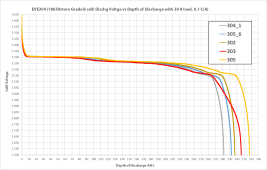Sam Cho TX
Solar Enthusiast
Yes absolutely LOL ?I at least know this much
Notice the end of discharge voltage decay drop off on cell 303.
It is quite different of the other cells and is indicative of a cell that has not had enough initial cycles where the cathode and anode capacity curves have not reached their final alignment. It may gain in AH's after a few cycles. It would surprise me they did not catch this and do more cycles to correct.
It is also possible the neg anode graphite print thickness was on the thin side so anode does not have the extra 15-20% graphite. This would be bad as not only will it produce less AH's of capacity but it will also age quicker than other cells. This would be a manufacturing process control screw up. (something that never happens in China)
These graphs are plotted with X axis in incremental AH's consumed, not the time increments that the zketech plots out.
View attachment 142705
View attachment 142713
Wow those results are bad! I say recharge and run it again just to be sure. Sunshine looks like the lowest cell went to 2.58 then it looked it like bounced back up on to down to 2.6 again.
Thats a neat graph, can you use the sfk app on a JBD 8s? I downloaded it but it did not detect it.

My problem with your tests, how do you know your equipment is accurate to the margin you're trying to test to?
What makes you think your setup is capable of doing 100% accurate tests and that you are doing the tests properly?
You will have a tough time keeping them in balance if you run a near full discharge, more than about 230 AH DoD. Absolute max discharge will be limited to ballpark of 280 AH, after which you will need to do some significant rebalancing. Only as strong as weakest link. Greater load current may make things worse.
You have two really poor cells from the data you attached, 304.1 and 303. Only 305 comes close to looking like a 304 AH cell.
View attachment 143243
OP did you contact 18650 what did they say?
Also sent them the link to this thread.I sent them an email, will try to call tomorrow, but if I have to pay to ship back and get a 20% restocking fee I'm just not going to bother and just take the loss and move.
I'm planning on buying 64 cells for a large 48v bank, I also have luyuan 304 matched and batched genuine on order 4 to try out.
I dunno. It would seem like accurate testing would require overcharge and then going down to below comfort level.
And then look at the ending voltage.
How does the factory test them?
Hard lesson on the crap shoot of grade B cells. As Forest Gump said, 'Like a box of chocolates.'I sent them an email, will try to call tomorrow, but if I have to pay to ship back and get a 20% restocking fee I'm just not going to bother and just take the loss and move.
I'm planning on buying 64 cells for a large 48v bank, I also have luyuan 304 matched and batched genuine on order 4 to try out.
You mentioned earlier about one of the cells not being cycled enough and that capacity might increase with the number of cycles; can these be easy cycles or does the cell/cells need to sustain a certain charge/discharge rate for a certain length of time and number of cycles?Greater than 80% discharged.,
I gave a couple of possible reasons for cell 303 discharge curve, one of which was possible improvement with cycling. More likely is the anode was manufactured with thinner graphite paste printing yielding lower anode capacity.You mentioned earlier about one of the cells not being cycled enough and that capacity might increase with the number of cycles; can these be easy cycles or does the cell/cells need to sustain a certain charge/discharge rate for a certain length of time and number of cycles?
No, as per standard testing for LiFePO4: charge to 3.65V and saturate (tail current), discharge until the voltage drops to 2.5V. Discharge rate:
AH calculations accuracy relies on accurate current measurements and accurate sample time increments. WH accuracy also needs accurate voltage increments measurements.What if my load tester is off by .1 amps or there is outside interference or only discharge to 2.51 volts etc.


